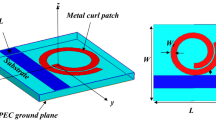Abstract
This paper reviews recent advances in fully printed chipless radio frequency identification (RFID) technology with special concern on the discussion of coding theories, ID generating circuits, and tag antennas. Two types of chipless tags, one based on time-domain reflections and the other based on frequency domain signatures, are introduced. To enable a fully printed encoding circuit, linearly tapering technique is adopted in the first type of tags to cope with parasitic resistances of printed conductors. Both simulation and measurement efforts are made to verify the feasibility of the eight-bit fully printed paper-based tag. In the second type of tags, a group of LC tanks are exploited for encoding data in frequency domain with their resonances. The field measurements of the proof-of-concept of the tag produced by toner-transferring process and flexible printed circuit boards are provided to validate the practicability of the reconfigurable ten-bit chipless RFID tag. Furthermore, a novel RFID tag antenna design adopting linearly tapering technique is introduced. It shows 40 % save of conductive ink materials while keeping the same performance for conventional half-wave dipole antennas and meander line antennas. Finally, the paper discusses the future trends of chipless RFID tags in terms of fabrication cost, coding capacity, size, and reconfigurability. We see that, coupled with revolutionary design of low-cost tag antennas, fabrication/reconfiguration by printing techniques, moving to higher frequencies to shrink tag sizes and reduce manufacturing cost, as well as innovation in ID generating circuits to increase coding capacities, will be important research topics towards item-level tracking applications of chipless RFID tags.
















Similar content being viewed by others
References
Preradovic S, Karmakar NC (2010) Chipless RFID: bar code of the future. IEEE Microwave Magazine 11(7):87–97
Tedjini, S., Perret, E., Deepu, V., Bernier, M.: Chipless tags, the next Rfid frontier. The Internet of Things, pp. 239–249 (2010)
Fletcher RR (2002) Low-cost electromagnetic tagging: design and implementation. Ph.D Dissertation, MIT
Subramanian V, Frechet JMJ, Chang PC, Huang DC, Lee JB, Molesa SE, Murphy AR, Redinger DR, Volkman SK (2005) Progress toward development of all-printed RFID tags: materials, processes, and devices. Proceedings of the IEEE 93(7):1330–1338
Harrop P, Das R, Rfid F (2005) Printed and chipless RFID forecasts, technologies & players, and opportunities 2005–2015, IDTechEx
Blischak AT, Manteghi M (2011) Embedded singularity chipless Rfid tags, antennas and propagation. IEEE Transactions on 59(11):3961–3968
Plessky V, Reindl L (2010) Review on saw Rfid tags. Ultrasonics, Ferroelectrics and Frequency Control, IEEE Transactions on 57(3):654–668
Harma S, Arthur WG, Hartmann CS, Maev RG, Plessky VP (2008) Inline saw Rfid tag using time position and phase encoding. Ultrasonics Ferroelectrics and Frequency Control, IEEE Transactions on 55(8):1840–1846
Shrestha S, Balachandran M, Agarwal M, Phoha VV, Varahramyan K (2009) A chipless Rfid sensor system for cyber centric monitoring applications. Microwave Theory and Techniques, IEEE Transactions on 57(5):1303–1309
Lakafosis V, Rida A, Vyas R, Li Y, Nikolaou S, Tentzeris MM (2010) Progress towards the first wireless sensor networks consisting of inkjet-printed, paper-based Rfid-enabled sensor tags. Proceedings of the IEEE 98(9):1601–1609
Orecchini G, Alimenti F, Palazzari V, Rida A, Tentzeris MM, Roselli L (2011) Design and fabrication of ultra-low cost radio frequency identification antennas and tags exploiting paper substrates and inkjet printing technology, microwaves, antennas & propagation. IET 5(8):993–1001
Li Y, Orecchini G, Shaker G, Ho-Seon L, Tentzeris MM (2010) Battery-free Rfid-enabled wireless sensors. Microwave Symposium Digest (MTT), 2010 I.E. MTT-S International
Lu Z, Rodriguez S, Tenhunen H, Li-Rong Z (2006) An innovative fully printable Rfid technology based on high speed time-domain reflections. Conference on, High Density Microsystem Design and Packaging and Component Failure Analysis
Zheng LL, Rodriguez S, Zhang L, Shao BT, Zheng LR (2008) Design and implementation of a fully reconfigurable chipless Rfid tag using inkjet printing technology. Proceedings of 2008 I.E. International Symposium on Circuits and Systems 1–10:1524–1527
Jalaly I, Robertson ID (2005) Capacitively-tuned split microstrip resonators for Rfid barcodes. in Microwave Conference, 2005 European IEEE
Jalaly I, Robertson ID (2005) RF barcodes using multiple frequency bands. In Microwave Symposium Digest, 2005 I.E. MTT-S International
Hyeong-Seok J, Won-Gyu L, Kyoung-Sub O, Seong-Mo M, Jong-Won Y (2010) Design of low-cost chipless system using printable chipless tag with electromagnetic code. IEEE Microwave and Wireless Components Letters 20(11):640–642
Vena A, Perret E, Tedjini S (2011) Chipless Rfid tag using hybrid coding technique. Microwave Theory and Techniques, IEEE Transactions on 99(12):3356–3364
McVay J, Hoorfar A, Engheta N (2006) Space-filling curve Rfid tags. In Radio and Wireless Symposium, IEEE
Namsoo L, Jaeyoung K, Soojin L, Namyoung K, Gyoujin C (2009) Screen printed resonant tags for electronic article surveillance tags. IEEE Transactions on Advanced Packaging 32(1):72–76
Preradovic S, Balbin I, Karmakar NC, Swiegers GF (2009) Multiresonator-based chipless Rfid system for low-cost item tracking. IEEE Transactions on Microwave Theory and Techniques 57(5):1411–1419
Manteghi M (2010) A novel approach to improve noise reduction in the matrix pencil algorithm for chipless Rfid tag detection. In Antennas and Propagation Society International Symposium (APSURSI), IEEE
Mukherjee S (2007) Chipless radio frequency identification by remote measurement of complex impedance. European Conference on Wireless Technologies, pp. 32–35
Balbin I, Karmakar NC (2009) Phase-encoded chipless Rfid transponder for large-scale low-cost applications. IEEE Microwave and Wireless Components Letters 19(8):509–511
Islam MA, Karmakar NC (2012) A novel compact printable dual-polarized chipless Rfid system. Microwave Theory and Techniques, IEEE Transactions on 60(7):2142–2151
Chamarti A, Varahramyan K (2006) Transmission delay line based ID generation circuit for RFID applications. Microwave and Wireless Components Letters, IEEE 16(11):588–590
Preradovic S, Balbin I, Karmakar NC, Swiegers, G (2008) Chipless frequency signature based RFID transponders. Wireless Technology & EuWiT 2008, European Conference on
Vemagiri J, Chamarti A, Agarwal M, Varahramyan K (2007) Transmission line delay based radio frequency identification (RFID) tag. Microwave and Optical Technology Letters 49(8):1900–1904
Sanming H, Yuan Z, Choi Look L, Wenbin D (2008) Study of a uniplanar monopole antenna for passive chipless UWB-Rfid localization system. IEEE Transactions on Antennas and Propagation 58(2):271–278
Preradovic S, Karmakar NC (2009) Design of fully printable chipless Rfid tag on flexible substrate for secure banknote applications. In Anti-counterfeiting, Security, and Identification in Communication, 3rd International Conference
Schuler M, Mandel C, Maasch M, Giere A, Jakoby R (2009) Phase modulation scheme for chipless RFID- and wireless sensor tags. In Asia Pacific Microwave Conference, (APMC 2009), pp. 229–232
Preradovic S, Karmakar NC (2009) Design of fully printable planar chipless RFID transponder with 35-bit data capacity. In European Microwave Conference
Islam MA, Karmakar N (2011) Design of a 16-bit ultra-low cost fully printable slot-loaded dual-polarized chipless Rfid tag. in Asia-Pacific Microwave Conference Proceedings (APMC)
Dardari D, D'Errico R, Roblin C, Sibille A, Win MZ (2010) Ultrawide bandwidth Rfid: the next generation? Proceedings of the IEEE 98(9):1570–1582
Zou Z, Mendoza DS, Wang P, Zhou Q, Mao J, Jonsson F, Tenhunen H, Zheng L-R (2011) A low-power and flexible energy detection IR-UWB receiver for Rfid and wireless sensor networks. IEEE Transactions on Circuits and Systems I-Regular Papers 58(7):1470–1482
Shao B, Chen Q, Amin Y, Mendoza D S, Liu R, Zheng L R (2010). An ultra-low-cost RFID tag with 1.67 Gbps data rate by ink-jet printing on paper substrate. In 2010 IEEE Asian Solid State Circuits Conference (A-SSCC), pp. 1–4
Shao B, Chen Q, Liu R, Zheng L R (2011). A reconfigurable chipless RFID tag based on sympathetic oscillation for liquid-bearing applications. In 2011 IEEE International Conference on RFID, pp. 170–175
Shao B, Chen Q, Liu R, Zheng L R (2011). Linearly-tapered RFID tag antenna with 40% material reduction for ultra-low-cost applications. In 2011 IEEE International Conference on RFID, pp. 45–49
Silver S (1924) Microwave Antenna Theory and Design, the Institution of Electrical Engineering
Jung HC, Cho SH, Joung JW, Oh YS (2007) Studies on inkjet-printed conducting lines for electronic devices. Journal of electronic materials 36(9):1211–1218
Preradovic S, Balbin I, Karmakar NC, Swiegers G (2008) A novel chipless Rfid system based on planar multiresonators for barcode replacement. In RFID, IEEE International Conference on
Karmakar NC, Roy SM, Preradovic S, Vo TD, Jenvey S (2006) Development of low-cost active RFID tag at 2.4 GHz. In Microwave Conference, 36th European
Acknowledgments
This work was financially supported by Vinnova (The Swedish Governmental Agency for Innovation Systems) through the Vinn Excellence centers program iPack Center and by the EU project CLIP of grant number 243557 through EU FP7-SME-2008-2.
Author information
Authors and Affiliations
Corresponding author
Rights and permissions
About this article
Cite this article
Shao, B., Chen, Q., Amin, Y. et al. Chipless RFID tags fabricated by fully printing of metallic inks. Ann. Telecommun. 68, 401–413 (2013). https://doi.org/10.1007/s12243-013-0378-3
Received:
Accepted:
Published:
Issue Date:
DOI: https://doi.org/10.1007/s12243-013-0378-3




